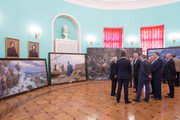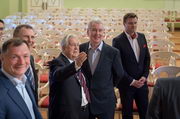Historical background
The Russian Academy of Painting, Sculpture and Architecture is located in a building designed by the outstanding Russian architect V.I. Bazhenov on Myasnitskaya Street, 21, — a historical monument of the XVIII century.
Built in 1780-1790 for Lieutenant General I.I. Yushkov, the house became a popular grand-secular salon of the capital. After the Yushkovs death, the house belonged to P.I. Yushkov, their son. By this time, the financial affairs of this family fell into disrepair, which forced the owner to sublet part of the premises under the drawing class — to the Moscow Art Society in 1838. From this date onwards, a new life of Yushkov's house began, connected with the Moscow Public School of Arts.
The heads and organizers of the Moscow (public) art school at the time were M.F. Orlov, A.D. Chertkov, F.Y. Skaryatin, E.I. Makovsky. Their project stipulated that the new school should provide opportunities for talents from the grass roots.
The main elected director of the artistic class and the most active member of the Art Society was General M.F. Orlov, the hero of the Patriotic War of 1812.
The art class was recognized by the government authorities only in 1843. It began to appear in 1844 in the affairs of the Moscow school district, when the Moscow Art Society acquired the entire building.
By the end of the XIX century, the School had actually gained the status of a higher educational institution, later confirmed by the highest order signed by Nicholas II to grant the Moscow Art School the rights of a higher educational institution with full independence in its educational part in 1905.
The Moscow School of Painting differed from other educational institutions in terms of democratic admission conditions and a truly creative environment. This art school united creative youth, for whom the main principle of creativity in art was realism.
Many of the teachers of the School became members of the Association of Traveling Art Exhibitions.
Since 1865, in the wake of affiliation of the the Moscow School of Architecture, the School began to be called the School of Painting, Sculpture and Architecture.
The leading class of the school was a life model class. It was headed by V.G. Perov, A. Ryabushkin, S. Korovin and many others. Landscape class was led by Academician of Painting A.K. Savrasov. Among his students were I.I. Levitan and K.A. Korovin — the greatest masters of Russian landscape. After A.K. Savrasov's death, the landscape class was led by P.D. Polenov and then by A.M. Vasnetsov. In the 1870s and 1890s, the school was taught by V. Pukirev, E. Sorokin, N. Nevrev, S. Korovin, L. Pasternak and others.
At this time, the school hosted exhibitions of famous artists, concerts and charity events. The old-standing house on Myasnitskaya Street always attracted many people. At the end of the XIX century, a four-storey educational building was added to the building of the house of Yushkov up the Bobrov Lane, and in the beginning of the XX century two eight-storey apartment houses for the faculty and students appeared in the courtyard.
At the same time, an exhibition hall was built in the yard according to the drawings of architect I.O. Kurdyukov.
The glazed roof of the hall was designed by a famous Russian engineer V.G. Shukhov, the author and constructor of the first radio and television tower in Moscow. After the revolutionary events of 1917, the School of Painting, Sculpture and Architecture ceased to exist, and in the premises on Myasnitskaya Street, 21, the first state art workshops were opened (the second were opened on the basis of the Stroganov School). Artists such as Lentulov, Konchalovsky, Mashkov, Rodchenko and others who were members of the Painters association "Jack of Diamonds", as well as Malevich and Kandinsky, who were the founders of abstract art, came to head the workshops.
At the end of 1920, the workshops were merged into the Higher Art and Technical Workshops — VHUTEMAS, the decree on the formation of which was signed by V.I. Lenin. These workshops were filled with people who disregarded artistic traditions and were against academic and old painting. Their slogan was the destruction of the old world "to the ground".
The further biography of the house is connected with VHUTEIN — the Higher art-technical institute which has been created in 1926 and existed till 1930. After that, the house on Myasnitskaya Street, 21 was occupied by several institutions.
Since 1942, the building was occupied by the Moscow Mechanical Institute, which trained physicists and mechanical engineers. In 1953, this university was renamed to the Moscow Engineering Physics Institute (MEPhI). In 1960 it was relocated to a new building on the Kashirskoye highway, and house 21 was taken by the All-Union Research and Design Institute for Industry Automated Control Systems (VNIPIoASU) and the organization of the Central Research Institute for Engineering and Information Technology with its departments, services and laboratories.
Thus, the building of the XVIII century — the so-called Yushkov's house — completely lost its Bazhenov's interiors. The facades of the building had also suffered greatly.
The new epoch in the life of Yushkov's house started with the name of the great Russian artist and public figure — People's Artist of the USSR, Professor Ilya Glazunov.
Back in 1986, when perestroika was just on its way in the country, Gazunov had the idea of creating a new higher art school, where the realistic traditions of the Russian art school — the St. Petersburg Academy of Arts and the Moscow School of Painting, Sculpture and Architecture — would be revived. His newly created All-Russian Academy of Painting, Sculpture and Architecture needed a residence and the obvious solution was to have it back in 21 Myasnitskaya Street.
The history of Yushkov's house continues.
Establishment of the Academy
I am often asked why I created a new educational institution twenty years ago — the Russian Academy of Painting, Sculpture and Architecture.
For many years I have been honored to head the portrait workshop I created at the Moscow Art Institute named after V.I. Surikov.
Here I had to involuntarily oppose the principles of the school of high realism to the methods of training the teachers of the Institute, who excluded the traditional drawing from gypsum, the work with grisaille and copying the masterpieces of old masters in museums following the study of their technology. I paid special attention to plastic anatomy. So were we taught in my student years in the Leningrad Institute named after I.E. Repin — the former Imperial Academy of Arts.
I was born and raised in Leningrad. I watched my parents and almost all my relatives die in the Siege. After returning from evacuation after 14 years, I entered the middle art school at the Institute named after I.E.Repin. I studied there from 1951 to 1957 and graduated with a degree in painting from B.V. Ioganson´s workshop. The inscription on the entrance to my alma-mater “To free arts. Year 1765” will stay with me forever.
The majestic building of the Academy on the banks of the Neva River is inspired by the glorious history of Russian art. With what thrill, at first pupils at first, and later students, climbed the steep stairs which were once walked up by many of our favourite artists — A.Losenko, A.Ivanov, K.Briullov, I.Repin, V.Surikov, V.Vasnetsov, A.Rjabushkin, M.Vrubel. High halls with copies of Raphael, Titian, Guido Renija, painted life in Rome by the best young scholars, the famous museum of ancient casts, drawing from which was cultivated in the old Academy, educational drawings and performances of future masters of the XVIII and XIX centuries — all this was remembered for life and determined my life.
The pedagogical canons of the Imperial Academy of Arts formed the basis for the upbringing of artists in my workshop at the Surikov Institute.
In 1987, not only my, but also my friends' conviction that "school for the artist is like wings", without mastering the knowledge of which the artist will remain an amateur forever, has become the reason for creation of a new educational institution in Russia. Previously, in Soviet times, for all the brotherly republics, except for the RSFSR, was given a job order, a certain number of places for admission to art universities, regardless of the level of talent and training.
Therefore, many gifted young people from the Russian province were deprived of this right. Bitterly obvious the realization of the need for an art university, where young talents of our multinational homeland would be accepted in fairness came down on me.
For the new university in Moscow, there was no better building than the Yushkov House, built by the brilliant Bazhenov. This house once housed the Imperial School of Painting, Sculpture and Architecture, where the great Russian painters studied and worked: V. Perov, M. Nesterov, A. Vasnetsov, V. Serov, A. Savrasov, I. Levitan. I decided to drive to 21 Msnitskaya Street and I involuntarily admired the mighty colonnade of the building, which was maintained in the best traditions of classicism.
But back then it was housing 22 Soviet institutions that occupied the building during and after the war, even the Andrei Sakharov Institute rented one of the wings. We had to invest a lot of money and spiritual strength to make the Academy look worthy. My comrades and I are proud that, having withstood a fierce struggle with the powerful authorities, we returned the temple of art to Russian artists, creating the Russian Academy of Painting, Sculpture and Architecture.
Today I am convinced that only he or she will become a true artist who, having absorbed the covenants of the school of high realism, will reflect the struggle of good and evil in the world, feeling the unfading beauty of harmony and the plan of God's peace.
May he, like Odysseus, swim between Scylla and Harybda, between wingless artisanal naturalism and the arbitrariness of abstract formwork.
The greatest mystery of any artist's work is the creation of an image. Art has always been divided into two inseparable principles — "what" and "how". What the artist wants to say — is giving birth to the form of his work. "Wake up contemporaries with majestic images of the Spirit", — called M.A. Vrubel. "My art is a candle lit before the face of God," said V.M. Vasnetsov. The study of nature, the transmission of its tonal and color relations determine the talent and path of the artist. Multi-figure painting — composition — like a novel in literature.
Ilya Repin said during the opening the All-Russian Congress of Artists in December 1911: "Art is the supreme gift of the Creator to the people, let's not profane it!“.
The artist always reflects on and understands the time he or she lives in. Be worthy of yourself, young artists, and fight for the great mission of being a creator, expressing the national consciousness of your people. The steps of the school of high realism are the steps in your soul. Be worthy of yourself in the terrible struggle of good and evil of our XXI century. Choose the freedom of creativity, not the slavery of the passing fashion.
The doors of our Academy are open for all those who want to become an artist. Nowadays, when the majority of the world's academies under the pressure of avant-gardism have lost the concept of "school", which defines the level of professionalism of the artist, we assert the principles of high skill, realism and spirituality, without which there can be no real great art.
Welcome to the sacred Temple of Art — the Russian Academy of Painting, Sculpture and Architecture.
Ilya Glazunov
Founder and Rector of the Russian Academy
painting, sculpture and architecture,
Merited Artist of the USSR, professor,
academic, honorary member of the Royal
of the Academies of Fine Arts of Madrid and
Barcelona, UNESCO Prize winner
Guests
Over the years, the Academy has hosted many famous politicians, public and cultural figures:

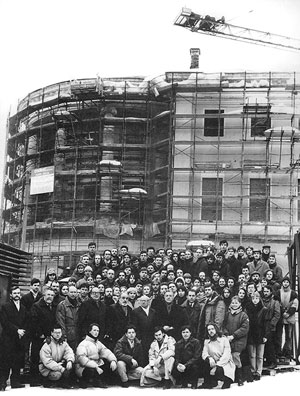
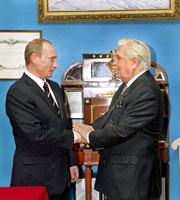
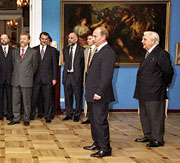
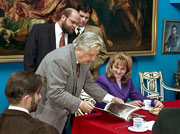
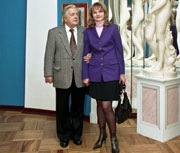
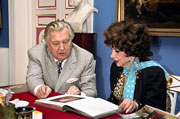
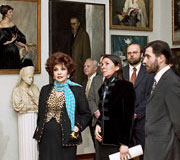
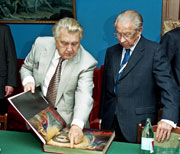

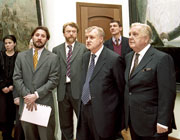
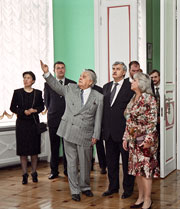
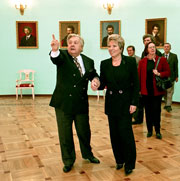
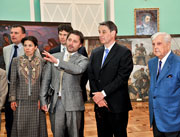
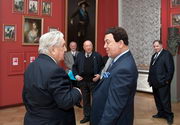
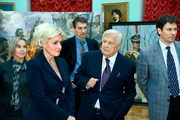
_t.jpg)
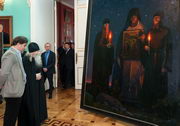
_t.jpg)

